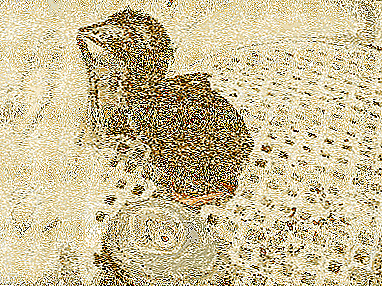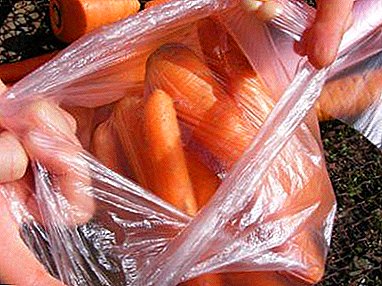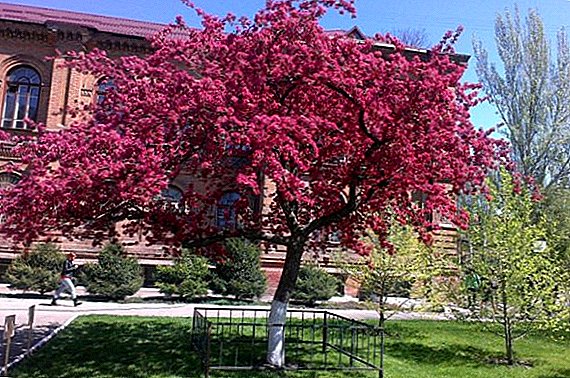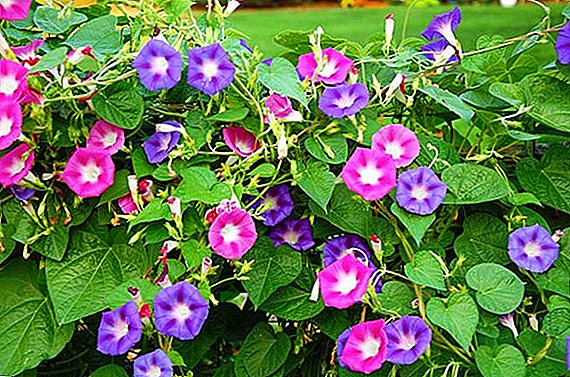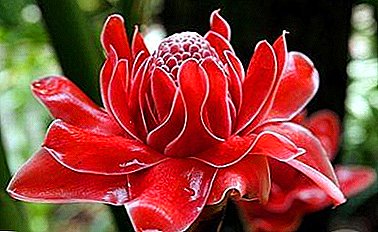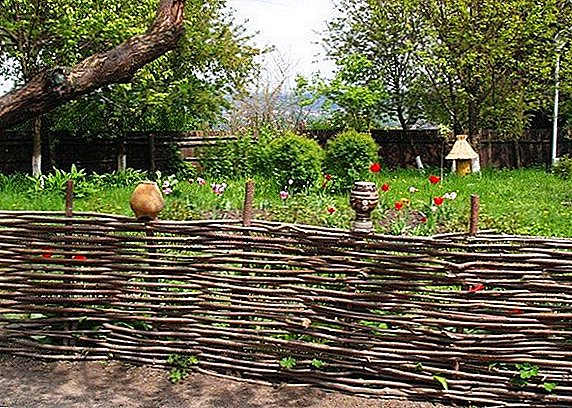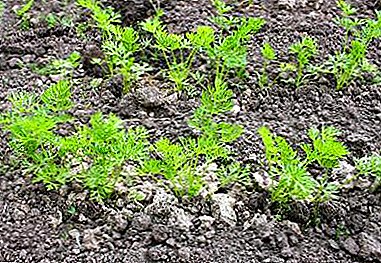
Often a rather simple technique for planting carrots can turn out to be a failure. There can be many reasons for this, as carrots are among those crops that love compliance with certain rules - this includes proper soil preparation, selection of high-quality seeds, and their preliminary preparation.
A number of important and not very labor-intensive operations will increase the likelihood of a good shoot of carrots and its further growth during the summer period.
From the article you will learn why seeds do not sprout or sprout for a long time and what to do if plants grown in the garden on the beds do not develop well and a lot of time has passed from sowing the seeds, but there is no result at all, for example, after a month, and Are there any folk remedies to improve the condition of seedlings?
How long to wait for seedlings and when should we worry about their absence?
 As a rule, the first shoots of carrots appear on average 10-30 days after planting. Such a large variation in time is due to many factors, namely:
As a rule, the first shoots of carrots appear on average 10-30 days after planting. Such a large variation in time is due to many factors, namely:
- Planting time carrots - for example, carrots, which were planted before winter, will rise faster than those that are planted in spring. When spring sowing, there are also differences - that carrot, which was planted in May, will be faster than the April carrot. If you cover the beds some time before planting, this will warm up the soil further and increase the chances of a quick germination of seeds.
- Soil type - light, fertile, loose soil and sandy soils contribute to the rapid germination of carrots.
- Ground moisture - a sufficiently moist soil before planting seeds is extremely important for good and fast carrot shoots.
- Has the seed been prepared (soaking, growth stimulation treatment).
- Climate zone - in the southern regions, the first shoots of carrots can be seen in 5-10 days, in cooler regions, the germination period is 15-30 days.
Causes of absence or rare shoots
- Poor quality soil - Often is the cause of poor germination of seeds.
- First, maybe the soil type itself is not very suitable for carrots to grow.
- Secondly, the soil may not be sufficiently prepared for planting.
Soil preparation and fertilization should be carried out in the autumn, using mainly organic fertilizers. Well rotted humus or compost, fresh manure for carrots is absolutely not suitable.In addition, the carrot loves the soil with a slight acidity (pH level of 5.5-7) - therefore, if the soil is strongly acidic, chalk can be used to deoxidize it. If the soil is too heavy, it should be mixed with peat, sawdust or river sand.
Carrots do not like to be planted in the same place for three years in a row. Therefore, it is recommended to periodically change the place, while respecting a number of some rules - cabbage, tomatoes, cucumbers, onions, and potatoes will be the best predecessors of carrots. Those areas where beets, dill, parsley, celery, parsnips, and cumin are not suitable for carrots are not suitable for carrots.
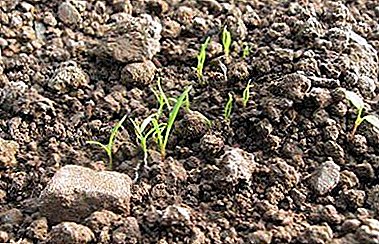 Defective seed - unfortunately, the reason for the lack of germination may be low-quality seeds. It is worth buying seeds in specialized, well-established stores. As a rule, such seeds are already prepared for sowing, treated for diseases and pests.
Defective seed - unfortunately, the reason for the lack of germination may be low-quality seeds. It is worth buying seeds in specialized, well-established stores. As a rule, such seeds are already prepared for sowing, treated for diseases and pests.If the seeds are purchased on the market, taken from friends or grown independently, it is worthwhile to carry out pre-sowing treatment (for example, immerse the seeds in a solution of micronutrients, soak in a solution with wood ash or use growth stimulants). In addition, it is worth remembering that improper storage of seeds before sowing can also spoil them.
- Excessive or insufficient seed penetration - If the seeds are planted too deep, it can also cause failure. If the soil is loose, then before planting the soil should be watered, then plant the seeds at a depth of no more than 1 cm, sprinkle with humus or sand on top. To avoid the formation of a crust on the surface, the bed can be covered with a film. If the seeds are planted too close to the ground, then spring or summer rain can wash away the seeds.
- Pests - In spring, not only plants awake, but also insects that actively eat seeds and young shoots, for example, ordinary ants.
- Lack of watering - carrots like moist soil, so before sowing it is recommended to pour enough of the future garden bed. Also, to preserve moisture, you can use the film, covering the garden after planting. In addition, the seeds contain essential oils that prevent water from entering the germ. To avoid this, it is recommended to pre-seed seed preparation, or buy seeds that have already been processed.
Step-by-step instruction: what to do if there are no sprouts?
What to do if the sprouts did not appear at the right time and the carrots did not grow?
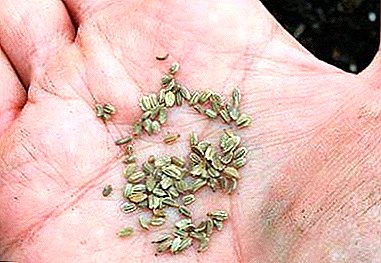 Special dressing - for carrots it is extremely important to prepare the soil. This can be done in the fall by adding organic fertilizers to the soil and carefully digging it up.
Special dressing - for carrots it is extremely important to prepare the soil. This can be done in the fall by adding organic fertilizers to the soil and carefully digging it up.If the autumn preparation was not carried out, or it is not possible to apply organic fertilizers, mineral fertilizers can be used - for this, 50 g of nitrogen, 50 g of potash and 40 g of phosphate fertilizers should be mixed per 1 m² of garden. After 2 weeks after planting, you can also conduct additional feeding - for this you should use a mixture of potassium sulfate (1 tbsp.) And azofoski (1 tbsp.), Which must be dissolved in 10 liters of water.
- Special care conditions - after planting, it is necessary to refrain from watering in the first week, as due to the lack of moisture, the carrot tends to turn out. That is why watering the beds should be done before sowing, and not after.
- Landing cover - after planting, especially if it is not about the southern regions, it is recommended to use a film to shelter the beds - thanks to the film, the seeds will be protected from frost, and moisture will remain in the soil longer. In addition, covering material will help slow the growth of weeds.
But at the same time, it is important that he did not slow down and shoot carrots - so it is worth checking the condition of the bed every day after planting, and as soon as the first shoots appear, remove the film.
- Watering ammonia (folk remedy) - ammonia is a nitrogenous fertilizer, which is often used as a growth promoter for carrots at the beginning of the growing season, as well as a means to control pests. The solution for the treatment of beds is prepared in the following proportion - 2 tbsp. l 10% ammonia is stirred in 10 liters of water.
When exactly do not need to wait for sprouts?
If after 30 days the first shoots have not appeared, it is necessary to plant again, while trying to eliminate errors, so as not to encounter the same problem again.
Preventing recurrence
If it has not yet come June 10-15, then you can have time to re-plant the carrots, after digging the bed. If you plan to plant late-ripening varieties, it is allowed to make the last planting on June 20-21.
A later sowing date will in itself increase the chances of good germination due to factors such as a warmer soil, a warmer temperature during the day, a decline in carrot fly activity (if replanting occurs in June), which causes the most serious damage to the future crop.
It is worth holding some preparatory activities, in particular:
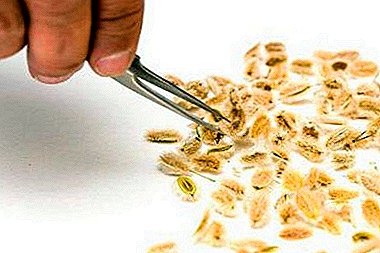 Weed out unsuitable seeds - for this they need to fill with warm water and leave for 10 hours. The bad seeds will float, and the good ones will settle to the bottom.
Weed out unsuitable seeds - for this they need to fill with warm water and leave for 10 hours. The bad seeds will float, and the good ones will settle to the bottom.- Additionally, you can prepare the seeds - soak for several hours in a solution with microfertilizers or in a solution with wood ash. After soaking the seeds are dried and planted. Also on the eve of sowing, you can simply soak the seeds for a day in a wet cloth.
- Before planting it is worth making sure that the soil is sufficiently wet. If not, then you need to carry out watering, and only after that to plant the seeds.
- During the landing it is important to remember about the optimal depth of landing - 1 cm.
- If the warm weather has not yet been established, you can cover the beds with film, but at the same time check the condition of the beds daily so as not to miss the moment when the film should be removed.
If the carrot is upset by the absence of the first shoots, it is worthwhile to understand the reasons and correct the mistakes made during the replanting. Proper adherence to the recommendations will increase the chances of success and enjoy the harvest of carrots at the end of the season.


 Defective seed - unfortunately, the reason for the lack of germination may be low-quality seeds. It is worth buying seeds in specialized, well-established stores. As a rule, such seeds are already prepared for sowing, treated for diseases and pests.
Defective seed - unfortunately, the reason for the lack of germination may be low-quality seeds. It is worth buying seeds in specialized, well-established stores. As a rule, such seeds are already prepared for sowing, treated for diseases and pests. Special dressing - for carrots it is extremely important to prepare the soil. This can be done in the fall by adding organic fertilizers to the soil and carefully digging it up.
Special dressing - for carrots it is extremely important to prepare the soil. This can be done in the fall by adding organic fertilizers to the soil and carefully digging it up. Weed out unsuitable seeds - for this they need to fill with warm water and leave for 10 hours. The bad seeds will float, and the good ones will settle to the bottom.
Weed out unsuitable seeds - for this they need to fill with warm water and leave for 10 hours. The bad seeds will float, and the good ones will settle to the bottom.